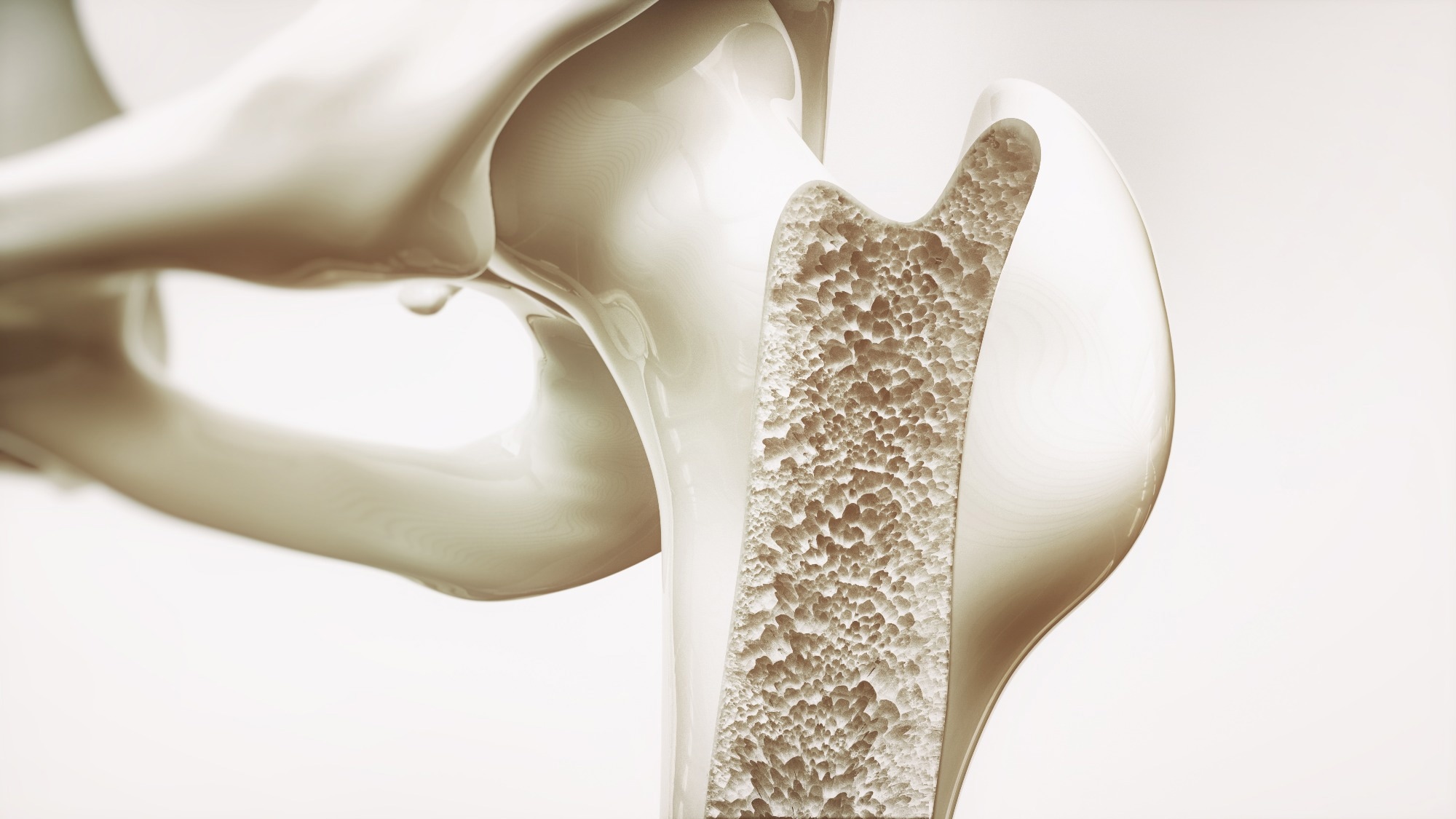A study of U.S. adults finds that excess central fat, measured by LAP, is linked to lower spinal bone density, only after reaching a certain tipping point, suggesting a new early warning sign for osteoporosis.
 Study: The association between lipid accumulation products and bone mineral density in U.S. Adults, a nationally representative cross-sectional study. Image Credit: Crevis / Shutterstock
Study: The association between lipid accumulation products and bone mineral density in U.S. Adults, a nationally representative cross-sectional study. Image Credit: Crevis / Shutterstock
In a recent study in the journal Scientific Reports, researchers evaluated the association between a new indicator of lipid accumulation, 'lipid accumulation products (LAP)', and bone mineral density (BMD). The study dataset comprised 3,883 (mean age = 39.33 yrs; 45.48% women) NHANES participants with analyses including subgroup, interaction, and threshold analyses, adjusted for covariates.
Study findings revealed a non-linear negative relationship between LAP and lumbar BMD, with the negative association observed only above a specific LAP threshold (ln-LAP ≈ 2.85); below this value, no significant association was found. Interaction analysis indicated no influence of subgroups, suggesting that the observed pattern held across demographic and health characteristics. These findings suggest the clinical utility of LAP as a bioindicator and predictor of osteoporosis, providing valuable insights that may lead to earlier intervention strategies in treating these chronic diseases.
Background
Osteoporosis is a bone condition characterized by severe weakening of bones (reduced bone mass), significantly increasing the likelihood of fracture, especially in adults over the age of 50. The chronic condition is a growing public health concern, with an estimated 158 million adults (>50 yrs) living with the condition. Alarmingly, prediction models suggest that this number will only double by 2040, highlighting the need for prevention, early detection, and intervention against this societal burden.
Previous research has established an association between osteoporosis and obesity, with the latter significantly exacerbating the former's risk. Interestingly, validated studies have revealed that body mass index (BMI) and waist circumference (WC) – obesity's most common metrics – are insufficient predictors of osteoporosis due to the latter's nuanced relationship with adipose tissue and lean tissue.
Lipid accumulation products (LAP) is a relatively novel lipid accumulation scoring system that combines serum triglyceride (TG) levels with WC to compute an estimate of central obesity. The measure has been at the center of recent scientific discussion and research due to growing evidence that it can potentially predict the risks of several health conditions, including diabetes and other metabolic syndromes, insulin resistance, nonalcoholic fatty liver disease, and even osteoarthritis. Unfortunately, the association between LAP and osteoporosis (bone mineral density [BMD]) has never been formally established.
About the study
The present study aims to address this knowledge gap and inform future research on interventions against osteoporosis by evaluating the relationship between LAP and BMD on a nationally representative United States (U.S.) cohort. The study hopes to facilitate improved recognition, early detection, and enhanced prevention of future osteoporosis incidence.
Study data were obtained from participants of the National Health and Nutrition Examination Survey (NHANES) program conducted by the U.S. National Center for Health Statistics (NCHS). Data from four NHANES survey periods (2011–2018) were enrolled, comprising demographic, medical examination, dietary records, and questionnaire data. Participants younger than 20 and those with missing lumbar BMD, LAP, or covariate data were excluded from subsequent analyses.
The exposure variable (LAP) was computed using the following formula: Men – WC (cm)–65 × TG (mmol/l), Women – WC (cm)–58 × TG (mmol/l). Data for these computations were obtained from serum sample triglyceride measurements. The outcome variable (lumbar BMD) was measured using a fan-beam densitometer conforming to International Society for Clinical Bone Densitometry (ISCD) guidelines.
Covariates of interest included age, race, gender, BMI, education, poverty income ratio (PIR), laboratory blood assays, smoking and alcohol status, and chronic disease status. Statistical analyses were carried out using linear regression models, weighted chi-squared tests, multivariate linear regression models, threshold effect analyses, and interaction analyses.
Study findings
Of the 39,156 NHANES records initially enrolled in the study, 16,539 and 18,374 were excluded based on age and missing data, respectively, leaving a final dataset of 3,883 participants (mean age = 39.33 yrs; 45.48% female). Regression models revealed a negative association between LAP and lumbar BMD, confirmed via threshold analyses that identified a threshold value for LAP (ln-LAP ≈ 2.85).
Importantly, the negative association between LAP and BMD was only observed when LAP values were above this threshold; below this point, no significant association was found. Surprisingly, subgroup and interaction analyses failed to highlight the significant impacts of any covariates on the study findings. This indicates that the negative association above the threshold is consistent across different demographic and health groups. Notably, associations between LAP and BMD were observed to be non-linear. Together, these findings suggest the untapped potential of leveraging LAP in the early detection of osteoporosis and the routine monitoring of overall bone health.
The study authors note that, while the analysis used a large, nationally representative dataset and adjusted for many potential confounders, it is cross-sectional in nature and therefore cannot establish causality. Additionally, the analysis was limited to lumbar spine BMD, as relevant data for femur BMD were unavailable in the used NHANES cycles. Further research is needed to clarify the biological mechanisms linking LAP and bone density and to verify these findings in prospective studies.
Conclusions
The present study uses a large, nationally representative U.S. dataset to establish and describe the relationship between LAP and BMD. Study findings indicate a non-linear negative correlation between the variables, with a significant association only above a defined LAP threshold, supporting LAP's clinical and research utility in future osteoporosis interventions.
Journal reference:
- Cui, A., Zhuang, Y., Wei, X. et al. The association between lipid accumulation products and bone mineral density in U.S. Adults, a nationally representative cross-sectional study. Sci Rep 15, 16373 (2025), DOI: 10.1038/s41598-025-00833-6, https://www.nature.com/articles/s41598-025-00833-6